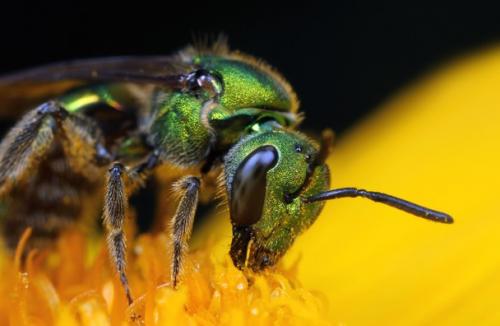Growing a variety of flowering plants helps bees and other beneficial insects
Growing a mixture of annuals, perennials and flowering trees and shrubs will help bees and other beneficial insects that provide natural control of plant pests.

Bees have been in the news this spring. Each week I see another article about the struggles of bees and beekeepers. Unfortunately, the challenges for professional beekeepers are being confused with advice for making our yards and gardens bee-friendly, when in fact there is very little connection. Professional beekeepers move their colonies to a sequence of agricultural crops during the spring and summer to provide crop pollination, so those bees are not usually foraging in our neighborhoods. However, the growing interest in the bees that frequent our yards and gardens does provide a great opportunity to explain the benefits of encouraging bees and beneficial insects in the yard and garden.
Plant a diversity of flowers that bloom all season long
Honey bees, bumble bees and many different species of smaller native bees are important for pollinating native plants and ornamental plants in your yard and garden. A healthy population of bees is critical for pollinating fruits and vegetables in the orchard and garden. The best way to encourage bees is plant a variety of annual flowers, perennials and flowering trees and shrubs so that you have a steady progression of flowering plants from early spring through summer and fall.
Although some annual flowers like marigold, verbena and salvia are better than others for bees, almost all annuals are visited by bees, and they bloom all through the growing season. Perennial flowers, like salvia, any of the mints, coneflowers and daisies, are very good for bees, and some of them, like hardy mums, are frost-resistant, so they will continue flowering through late September and October. Flowering trees and shrubs are very good for bees, too, especially ones that flower in early spring before most annual and perennial flowers are blooming.
Bee-friendly plantings will benefit other beneficial insects
Another important benefit of growing flowering plants is that they provide nectar and pollen for hundreds of species of tiny parasitic wasps (these don't sting humans) and predators that help to keep plant-feeding insects under control. You have probably noticed that trees in woodlots and in the forest are not usually plagued by hungry insects. That is because of predators and parasites that naturally keep them under control. Many of these parasites need pollen or nectar to sustain them in the adult stage when they are searching for caterpillars, aphids and other plant-feeding insects to deposit their eggs inside of. Predators also need pollen to supplement their diet or to sustain them at times when prey is hard to find. So, providing a variety of flowering plants will help predators and parasites that naturally keep plant pests under control.
Use as few insecticides as possible and never spray blooming flowers
Another way to encourage bees and beneficial insects is to avoid spraying insecticides as much as possible, and never spray blooming flowers. Spraying insecticides will sometimes cause an outbreak of spider mites, aphids or other plant pests because you have killed lots of beneficial insects which tend to be more sensitive to pesticides than the plant-feeding insects. Even after planting lots of flowers and avoiding pesticides, you may still see some damage from plant-feeding insects. For caterpillars, products containing Bacillus thuringensis or B.t. can be used without harming bees and beneficial insects.
Another bee-friendly option is to use horticultural oil or an insecticidal soap. They are effective on most soft-bodied insects and can be used on cool mornings (less than 50 degrees Fahrenheit), after sunset, or at any time that bees are not present. The soap and oil residue is not harmful to bees, but spraying them directly is. Soap and oil can cause some plant injury, especially to open flowers, so do not exceed the rate given on the product label. In rare cases where a plant needs to be protected against damaging insects by using a broad-spectrum insecticide, it should be sprayed after the plant is done blooming.
A native sweat bee feeding on pollen. Photo credit: Noah Fram-Schwartz
What about neonicotinoid insecticides?
As with all insecticides, do not spray neonicotinoids on flowers. Also, avoid using products containing imidacloprid or clothianidin as a soil drench around plants that attract bees. Using them as a drench around the base of wind-pollinated trees and shrubs, such as most evergreens and trees like oaks and ash, is not likely to harm bees because bees rarely visit wind-pollinated plants.
What about the pesticides used on flowers, trees and shrubs sold at garden centers?
Nursery growers and greenhouse growers have been working closely with Michigan State University on how to grow plants that are safe for bees and other pollinators. They are following best management practices that include using alternatives to neonicotinoid insecticides and they avoid spraying flowers close to when they are shipped to garden centers to make plants as safe as possible for pollinators.
For more information on identifying and encouraging pollinators, see the Michigan State University Extension bulletin on “Native Bees and Their Conservation on Farmland” by Rufus Isaacs and Julianna Tuell (http://bit.ly/conservBees).
Dr. Smitley's work is funded in part by MSU's AgBioResearch.



 Print
Print Email
Email


